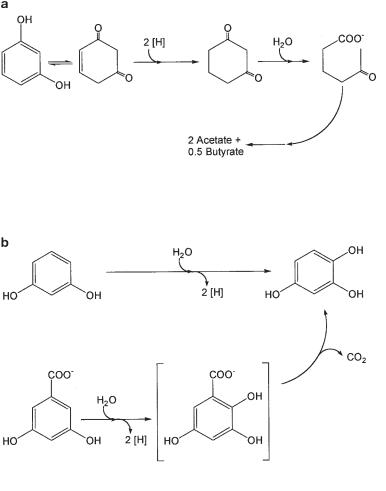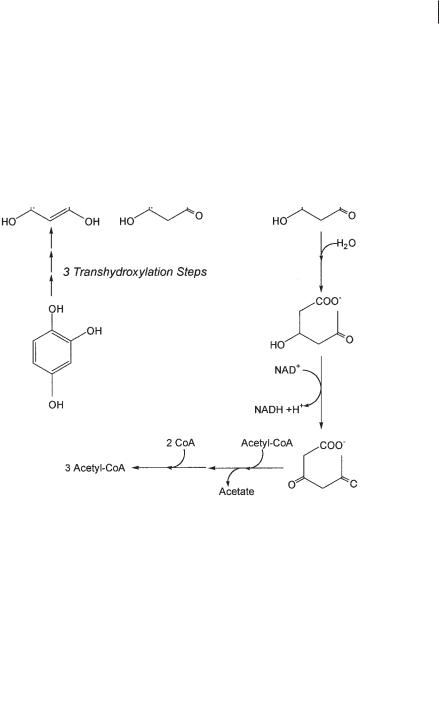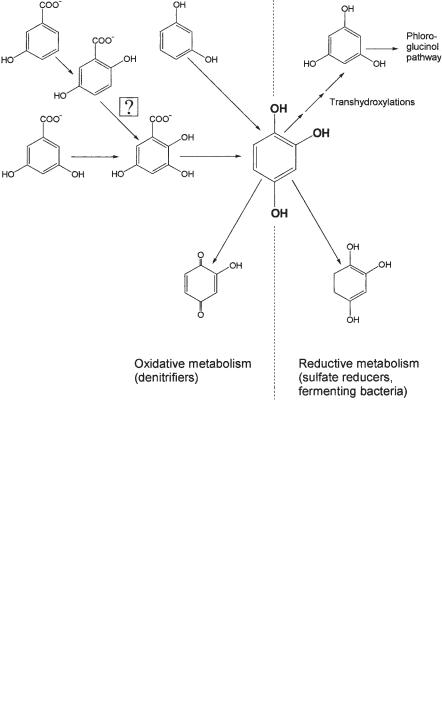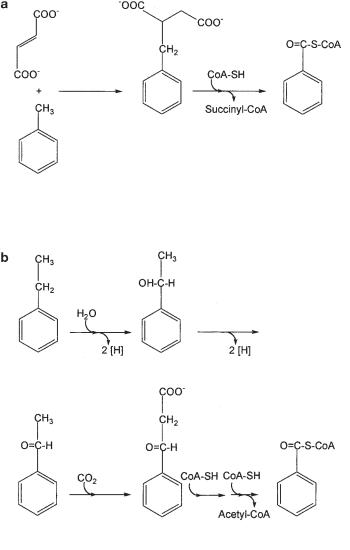
Environmental Biotechnology - Jordening and Winter
.pdf
242 8 Principles of Anaerobic Degradation of Organic Compounds
Anaerobic degradation of resorcinol and α-resorcylate. (a) Resorcinol degradation by a fermenting bacterium, Clostridium strain KN245, (b) degradation of resorcinol and α−resorcylate by nitrate-reducing bacteria.
8.2.6.6 Trihydroxybenzenes and Trihydroxybenzoates
Among the three trihydroxybenzene isomers, pyrogallol and phloroglucinol are degraded quickly by fermenting bacteria (Schink and Pfennig, 1982). Phloroglucinol degradation has been studied in detail with Eubacterium oxidoreducens and Pelobacter acidigallici. Phloroglucinol is reduced by an NADPH-dependent reductase to dihydrophloroglucinol (Fig. 8.9; Haddock and Ferry, 1989; Brune and Schink, 1992), and the same strategy is followed by Holophaga foetida strain TMBS4 (Kreft and Schink, 1993). Hydrolytic ring cleavage leads to 3-hydroxy-5-oxohexanoic acid, which is thiolytically cleaved to three acetate residues (Brune and Schink, 1992). This pathway is easy to conceive, because the 1,3,5 arrangement of three hydroxyl groups on

8.2 Key Reactions in Anaerobic Degradation of Certain Organic Compounds 243
the aromatic ring allows tautomerization to 1,3,5-trioxocyclohexane to an extent that makes the molecule susceptible to a nucleophilic attack on the oxocarbon groups. The second trihydroxybenzene isomer, pyrogallol, cannot be hydrolyzed directly but is isomerized to phloroglucinol through a transhydroxylation reaction (Fig. 8.9; Krumholz and Bryant, 1988; Brune and Schink, 1990). The reaction requires 1,3,4,5- tetrahydroxybenzene as a cosubstrate, and the enzyme transfers a hydroxyl group from the tetrahydroxybenzene to pyrogallol, thus releasing phloroglucinol as product and the tetrahydroxybenzene as coproduct (Brune and Schink, 1990; Reichenbecher et al., 1996).
Fig. 8.9 Degradation of trihydroxybenzenes by fermenting bacteria.

244 8 Principles of Anaerobic Degradation of Organic Compounds
8.2.6.7 Hydroxyhydroquinone, a New Important Intermediate
The third trihydroxybenzene isomer, hydroxyhydroquinone, is converted by the fermenting bacterium Pelobacter massiliensis to three acetates via three subsequent transhydroxylation reactions, analogous to the pyrogallol–phloroglucinol transhydroxylation (Schnell et al., 1991; Brune et al., 1992). Alternative pathways of hydroxyhydroquinone degradation were found in nitrate-reducing and sulfate-reducing bacteria. Hydroxyhydroquinone degradation by nitrate-reducing bacteria was mentioned above in the context of nitrate-dependent resorcinol degradation (Philipp and Schink, 1998). The reaction sequence leads to an acetate and a succinate residue, suggesting that the hydroxyhydroquinone intermediate is cleaved between carbon atoms 1 and 2 and between 3 and 4 (Fig. 8.10). Another alternative pathway of hydroxyhydroquinone degradation was found in the sulfate-reducing bacterium Desul- fovibrio inopinatus. This bacterium destabilizes hydroxyhydroquinone by reduction to dihydrohydroxyhydroquinone, to form acetate and an as-yet unidentified 4-carbon derivative (Reichenbecher et al., unpublished data). Since D. inopinatus is unable to
Fig. 8.10 Hydroxyhydroquinone as a new intermediate in anaerobic degradation of various aromatic compounds.

8.2 Key Reactions in Anaerobic Degradation of Certain Organic Compounds 245
oxidize acetate, the final products are two acetate and two CO2, and one mole of sulfate is reduced concomitantly to sulfide.
Hydroxyhydroquinone has gained additional interest recently because it was found to be an intermediate in the nitrate-dependent degradation of resorcinol, 3-hy- droxybenzoate, 3,5-dihydroxybenzoate, and perhaps also gentisate. The strategy of oxidative destabilization of aromatic compounds through hydroxylation, which these nitrate-reducing bacteria use, resembles to some extent the strategy of aerobic bacteria, and nitrate-dependent degradation of phenolic compounds thus follows a strategy that is somewhat of a mix between the oxidative aerobic strategy and the typical reductive strategy followed by strictly anaerobic bacteria.
8.2.6.8Aromatic Hydrocarbons
Anaerobic degradation of aromatic hydrocarbons has been a matter of dispute for several years until reliable conversion balances with fast growing enrichment cultures or pure cultures were provided. Today, several pure cultures of nitrate-reduc- ing or sulfate-reducing bacteria are available which oxidize toluene (methylbenzene) and have been characterized in detail (Dolfing et al., 1990; Schocher et al., 1991; Evans et al., 1991; Altenschmidt and Fuchs, 1991; Seyfried et al., 1994; Rabus et al., 1993; Rabus and Widdel, 1995; Beller et al., 1996; Spormann and Widdel, 2000). Initial experiments indicated that toluene degradation proceeded through oxidation of the methyl group (Altenschmidt and Fuchs, 1991), with benzoyl-CoA as central intermediate. Nonetheless, the anticipated methyl hydroxylation reaction transforming toluene to benzylalcohol could never be observed in vitro. Labeling experiments with intact cells provided evidence that toluene was activated by addition of fumarate, through a radical intermediate, to form benzyl succinate (Fig. 8.11a; Biegert et al., 1996), and this mechanism was confirmed in nitrate-reducing and sulfate-reduc- ing bacteria (Beller and Spormann, 1997a, b, 1998). Benzylsuccinate synthase has been characterized in great detail in the meantime (Achong et al., 2001; Verfurth et al., 2004). Benzylsuccinate releases succinyl-CoA through beta oxidation, leading again to benzoyl-CoA as key intermediate. This new type of methyl group activation is also employed in anaerobic degradation of alkanes and of m−cresol (see above).
Anaerobic degradation of o-, m-, and p-xylene has been documented mostly by tracer experiments with sediment samples or in enrichment cultures. Pure cultures of sulfate-reducing xylene degraders are now available (Harms et al., 1999), and evidence is available that at least m-xylene is activated by addition to fumarate (Krieger et al., 1999; Verfurth et al., 2004).
Ethylbenzene is oxidized by denitrifying and sulfate-reducing bacteria (Rabus and Widdel, 1995; Ball et al., 1996; Rabus and Heider, 1998). Here, the sidechain is hydroxylated to form 1-phenylethanol as the first oxidation product (Fig. 8.11b; Ball et al., 1996; Rabus and Heider, 1998; Johnson and Spormann, 1999). The oxidizing enzyme is a novel molybdenum enzyme (Johnson et al., 2001). The subsequent pathway leads via oxidation to acetophenone and carboxylation to benzoylacetate and then through thiolytic cleavage to an acetyl residue plus benzoyl-CoA (Heider et al., 1999).

246 8 Principles of Anaerobic Degradation of Organic Compounds
Fig. 8.11 Anaerobic degradation of (a) toluene and (b) ethylbenzene by nitrate-reducing or sul- fate-reducing bacteria.
Much less is known about anaerobic benzene oxidation. Oxygen-independent hydroxylation and degradation of benzene was observed in methanogenic enrichment cultures (Vogel and Grbic´-Galic´, 1986; Edwards and Grbic´-Galic´, 1994) and in sul- fate-reducing (Lovley et al., 1995), nitrate-reducing (Burland and Edwards, 1999), or iron(III)-reducing enrichments (Lovley et al., 1996). Isolation of a pure culture of ni- trate-reducing benzene degraders has been reported recently (Coates et al., 2001), but the biochemistry of benzene activation still remains an open question.

8.2 Key Reactions in Anaerobic Degradation of Certain Organic Compounds 247
Naphthalene is degraded anaerobically by various enrichments and also by pure cultures of sulfate-reducing bacteria (Galushko et al., 1999). Its degradation is probably initiated by a carboxylation reaction (Zhang and Young, 1997) and subsequent reductive dearomatization (Annweiler et al., 2002), but the details of this pathway have still to be worked out.
8.2.7
Degradation of Halogenated Organics
Halogenated organics are widespread in nature and are formed especially as secondary metabolites by plants, marine algae, fungi, and certain bacteria at low rates (for a review, see Hutzinger, 1982). It is not surprising, therefore, that a broad variety of bacteria and fungi can degrade such compounds and that this capacity has grown in the past to include also the majority of synthetic halogenated compounds. Dehalogenation can proceed basically through an oxidative, a hydrolytic, or a reductive reaction (Fetzner and Lingens, 1994; El Fantroussi et al., 1998). Among anaerobic bacteria, the reductive elimination of halogen substituents is the most common type of reaction and was first observed in enrichment cultures with 3,5-dihydroxybenzoate (Suflita et al., 1982). Later, several other aliphatic and aromatic compounds were found to be dehalogenated (mainly dechlorinated) in anoxic incubation experiments (Bouwer and McCarty, 1983), and today nearly all chlorinated organics can be dehalogenated and further degraded in strictly anaerobic microbial cultures. As a rule, reductive dechlorination is the preferred process for degradation of compounds with higher degrees of halogenation. The reaction is an excellent electron sink (Eh +250 to +580 mV), and highly halogenated compounds are much more amenable to a nucleophilic attack on the respective carbon atom than to an oxidative reaction.
The overall reaction of reductive dehalogenation can be diagrammed as in Figure 8.12 for a chlorinated compound: electrons derived from molecular hydrogen, formate, or more complex organic compounds are transferred to the halogenated substrate to release the organic residue in a reduced form, together with chloride. It has been shown in several instances that this redox process can yield metabolic energy through a respiratory mechanism, which implies that the process may establish a net translocation of protons across the cytoplasmic membrane and that the proton gradient drives ATP synthesis through a membrane-bound ATP synthase complex. The biochemistry of the dechlorination reaction has been studied best with bacteria converting tetrachloroethene via trichloroethene to dichloroethene (Holliger et al., 1999). The dechlorination reaction employs a corrinoid as cofactor, which attacks the carbon-chlorine linkage in its reduced Co(I) form and converts it to the Co(III) form, probably through two subsequent one-electron transfer reactions (Schumacher et al., 1997; Neumann et al., 1998; Neumann et al., 2002; Maillard et al., 2003). Whether this reaction mechanism is used also in the dehalogenation of aromatic compounds has still to be elucidated. There appear to be numerous differences with respect to the electron carriers involved and the spatial arrangement of the enzyme components in the cytoplasmic membrane.

248 8 Principles of Anaerobic Degradation of Organic Compounds
Fig. 8.12 Reductive dehalogenation of a chloroorganic compound.
Halo-organics can also be reductively dehalogenated by reduced Fe(II) phases (Pecher et al., 2002; Elsner et al., 2004) that are formed on the surface of Fe(III) minerals.
8.2.8
Degradation of Sulfonates
Sulfonated organics are rare in nature: only taurine, coenzyme M, cysteate, and a few secondary metabolites are known to contain sulfonate substituents. Aerobic degradation of such compounds typically requires an oxygenase reaction, which hydroxylates the neighboring carbon atom and releases sulfite (Cook et al., 1999). Some sulfonates can also be partly degraded in the absence of molecular oxygen and can serve as sulfur sources under conditions of sulfur limitation (Chien et al., 1995; Cook et al., 1999). The biochemistry of anaerobic sulfur release from sulfonates has been studied extensively with taurine and related compounds, which are metabolized through sulfoacetaldehyde as key intermediate (Laue et al., 1997a, b). The sulfono group is released from sulfoacetaldehyde probably through a thiamine pyro- phosphate-dependent reaction that forms sulfite and an acetyl residue, analogous to the reaction elucidated earlier with an aerobic bacterium (Kondo and Ishimoto, 1975). Since this desulfonation reaction requires an oxo group positioned â to the sulfur atom for linkage to the coenzyme, it remains questionable whether this concept can also be applied to desulfonation of commercial sulfonates, such as alkyl sulfonates or alkylbenzene sulfonates, which so far resist anaerobic degradation.
8.2.9
Degradation of Nitroorganics
Among the nitroaromatic compounds, trinitrotoluene (TNT) is of major importance as a soil pollutant because it has accumulated at old ammunition factory sites over several decades. The electron-withdrawing effect of the nitro substituents makes an oxidative attack on nitroaromatics rather difficult. Indeed, trinitrotoluene is attacked by aerobic bacteria primarily through a reductive reaction that transforms nitroaromatics to the corresponding amino derivatives (Naumova et al., 1989) or reductively eliminates the nitro groups via a so-called Meisenheimer complex (Vorbeck et al., 1994). In the presence of oxygen, the partly reduced derivatives can react with each other to form a rather inert polymer (Heiss and Knackmuss, 2002). A reductive approach is taken also by strictly anaerobic bacteria, e.g., sulfate-reducing bacteria: trinitrotoluene is converted via diaminonitrotoluene to triaminotoluene. Whereas the first step can also be catalyzed purely chemically without the participation of microbial cells or enzymes, reduction of diaminonitrotoluene to triaminotoluene requires the participation of microbial cells or enzyme fractions (Preuss et al., 1993). The fur-

8.3 Concluding Remarks 249
ther fate of triaminotoluene is unclear. It is partly utilized as a nitrogen source by a sulfate-reducing bacterium; the remnant product possibly polymerizes, especially in the presence of traces of oxygen (Preuss et al., 1993). The same is likely to happen in contaminated soils; so far, there is no reliable proof of complete degradation of TNT by anaerobic bacteria or by anaerobic and aerobic bacteria cooperating in a two-step process (see Chapter 11, this volume).
8.3
Concluding Remarks
Anaerobic degradation can be applied in technical devices for treatment of waste material, often leading to CH4 and CO2 as products, which can be exploited as energy source or as a basis for biosynthetic processes. Moreover, anaerobic degradation proceeds in many anoxic habitats such as the intestinal tracts of humans and animals, sediments, and oxygen-deprived microenvironments in soil, sewage sludge, etc. Knowledge of the capacities, strategies, and limits of anaerobic degradation processes is therefore needed to assess the potential risk of synthetic compounds to health or to the environment, no matter whether such synthetics are released intentionally (as with plant protection agents), inadvertently through wastewater treatment, or accidentally through spills.
This overview shows that the degradative potential of anaerobic microbial communities is much greater than assumed only a few years ago: a broad variety of compounds can be subject to anaerobic degradation, most often down to methane and carbon dioxide as final products. Aliphatic hydrocarbons are degraded if they contain unsaturated bonds, preferentially if these are located terminally, but saturated long-chain aliphatic hydrocarbons are also anaerobically degradable. These processes are slow and can be applied only in long-term incubations, if at all. Ether compounds are degraded anaerobically if they are methyl ethers or if they can be transformed into hemiacetals through, e.g., hydroxyl shift reactions. In the anaerobic degradation of ketones, the primary activation reaction is a carboxylation rather than an oxidation step.
Mononuclear aromatic compounds can be degraded anaerobically rather efficiently if they carry at least one carboxy, hydroxy, methoxy, amino, or methyl substituent, and four major degradation pathways have been elucidated in the recent past, which differ basically from the well known aerobic oxygenase-dependent pathways. The degradation kinetics differ considerably, depending on the sites of substitution.
Halogenated aliphatics and aromatics are reductively dehalogenated, more efficiently and better than by aerobes, the higher the degree of halogenation. Anaerobic degradation of sulfonates appears to be restricted to only a few compounds, whereas the majority of synthetic sulfonates (detergents) are degraded efficiently only in the presence of oxygen. Nitro-substituted compounds are preferentially attacked through reduction, and anaerobic processes therefore appear to be advantageous over aerobic ones. The same applies to azo compounds, which are not discussed here.

250 8 Principles of Anaerobic Degradation of Organic Compounds
Several types of reactions were identified which activate or destabilize comparably inert substrates in the absence of oxygen. Among these are carboxylations, addition to fumarate, reductions and reductive eliminations, rearrangements of aliphatic carbon skeletons, cobalamin-dependent nucleophilic substitutions, and oxygen-inde- pendent hydroxylations. Numerous reactions proceed through radical mechanisms, and the diversity of radical chemistry in the absence of oxygen appears to be considerably greater than in its presence.
Transformation of polymeric compounds is restricted in the anaerobic world to extracellular hydrolysis reactions unless the polymer can be taken up into the cell, as occurs with polyethylene glycol. There is no equivalent in the anoxic world to the fungal lignin-degrading enzyme apparatus. Therefore, polynuclear aromatics (lignin, other polyphenols) remain comparably recalcitrant in anoxic environments and represent barriers to microbial attack in the absence of molecular oxygen.
Acknowledgments
Experimental work in my laboratory has been funded mainly by the Deutsche Forschungsgemeinschaft, the Bundesministerium für Forschung und Technologie, the Fonds der Chemischen Industrie, and the University of Konstanz. Bodo Philipp and Jochen Müller designed the figures. Thanks are also due to the dedicated and talented graduate students who carried out the experimental work and contributed to the concepts with their own ideas. This overview is based on two review articles from our group (Schink, 1995; Schink et al., 2000), which cover special aspects of this survey.
References
Achong, G. R., Rodriguez, A. M., Spormann, A. M., Benzylsuccinate synthase of Azoar- cus sp. strain T: cloning, sequencing transcriptional organization, and its role in anaerobic toluene and m-xylene mineralization, J. Bacteriol. 2001, 183, 6763–6770.
Aeckersberg, F., Bak, F., Widdel, F., Anaerobic oxidation of saturated hydrocarbons to CO2 by a new type of sulfate-reducing bacterium, Arch. Microbiol. 1991, 156, 5–14.
Aeckersberg, F., Rainey, F. A., Widdel, F., Growth, natural relationships, cell fatty acids and metabolic adaptation of sulfate-re- ducing bacteria utilizing long-chain alkanes under anoxic conditions, Arch. Microbiol. 1998, 170, 361–369.
Altenschmidt, U., Fuchs, G., Anaerobic degradation of toluene in denitrifying Pseudo- monas sp.: indication of toluene methylhy-
droxylation and benzoyl-CoA as central aromatic intermediate, Arch. Microbiol. 1991, 156, 152–158.
Annweiler, E., Michaelis, W., Meckenstock, R. U., Identical ring cleavage products during anaerobic degradation of naphthalene, 2- methylnaphthalene, and tetralin indicate a new metabolic pathway, Appl. Environ. Microbiol. 2002, 68, 852–858.
Bache, R., Pfennig, N., Selective isolation of
Acetobacterium woodii on methoxylated aromatic acids and determination of growth yields, Arch. Microbiol. 1981, 130, 255–261.
Ball, H. D., Johnson, H. A., Reinhard, M., Spormann, A. M., Initial reactions in anaerobic ethylbenzene oxidation by a denitrifying bacterium, strain EB1, J. Bacteriol. 1996, 178, 5755– 5761.

Beller, H. R., Spormann, A. M., Anaerobic activation of toluene and o-xylene by addition to fumarate in denitrifying strain T, J. Bacteriol. 1997a, 179, 670–676.
Beller, H. R., Spormann, A. M., Benzylsuccinate formation as a means of anaerobic toluene activation by sulfate-reducing strain PRTOL1, Appl. Environ. Microbiol. 1997b,
63, 3729–3731.
Beller, H. R., Spormann, A. M., Analysis of the novel benzyl succinate synthase reaction for anaerobic toluene activation based on structural studies of the product, J. Bacteriol. 1998, 180, 5454– 5457.
Beller, H. R., Spormann, A. M., Sharma, P. K., Cole, J. R., Reinhard, M., Isolation and characterization of a novel toluene-degrad- ing sulfate-reducing bacterium, Appl. Environ. Microbiol. 1996, 62, 1188–1196.
Berman, M. H., Frazer, A. Z., Importance of tetrahydrofolate and ATP in the anaerobic O-demethylation reaction for phenylmethylethers, Appl. Environ. Microbiol. 1992, 58, 925–931.
Bernhardt, F. H., Staudinger, H., Ullrich, V., Eigenschaften einer p-Anisat-O-Demethyl- ase im zellfreien Extrakt von Pseudomonas species, Hoppe-Seyler’s Z. Physiol. Chem.
1970, 351, 467–478.
Biegert, T., Fuchs, G., Heider, J., Evidence that oxidation of toluene in the denitrifying bacterium Thauera aromatica is initiated by formation of benzylsuccinate from toluene and fumarate, Eur. J. Biochem. 1996, 238, 661–668.
Birks, S. J., Kelly, D. J., Assay and properties of acetone carboxylase, a novel enzyme involved in acetone-dependent growth and CO2 fixation in Rhodobacter capsulatus and other photosynthetic and denitrifying bacteria, Microbiology 1997, 143, 755–766.
Bisaillon, J. G., Lépine, F., Beaudet, R., Sylvestre, M., Carboxylation of o-cresol by an anaerobic consortium under methanogenic conditions, Appl. Environ. Microbiol. 1991,
57, 2131–2134.
Boetius, A., Ravenschlag, K., Schubert, C. J., Rickert, D., Widdel, F., Gieseke, A., Amann, R., Jorgensen, B. B., Witte, U., Pfannkuche, O., A marine microbial consortium apparently mediating anaerobic oxidation of methane, Nature 2000, 407, 623–626.
References 251
Boll, M., Fuchs, G., Benzoyl-CoA reductase (dearomatizing), a key enzyme of anaerobic aromatic metabolism: ATP dependence of the reaction, purification and some properties of the enzyme from Thauera aromatica strain K172, Eur. J. Biochem. 1995, 234, 921–933.
Boll, M., Fuchs, G., Tilley, G., Armstrong F. A., Lowe, D. J., Unusual spectroscopic and electrochemical properties of the 2[4Fe-4S] ferredoxin of Thauera aromatica, Biochemistry
2000, 39, 4929–4938.
Boll, M., Laempe, D., Eisenreich, W., Bacher, A., Mittelberger, T., Heinze J., Fuchs, G., Nonaromatic products from anoxic conversion of benzoyl-CoA with benzoyl-CoA reductase and cyclohexa-1,5-diene-1-carbonyl-CoA hydratase, J. Biol. Chem. 2000, 275, 21889–21895.
Bonnet-Smits, E. M., Robertson, L. A., Van Dijken, J. P., Senior, E., Kuenen, J. G., Carbon dioxide fixation as the initial step in the metabolism of acetone by Thiosphaera pantotropha, J. Gen. Microbiol. 1988, 134, 2281–2289.
Bouwer, E. J., McCarty, P. L., Transformation of halogenated organic compounds under denitrification conditions, Appl. Environ. Microbiol. 1983, 45, 1295–1299.
Breinig, S., Schiltz, E., Fuchs, G., Genes involved in anaerobic metabolism of phenol in the bacterium Thauera aromatica, J. Bacteriol.
2000, 182, 5849–5863.
Brune, A., Schink, B., Pyrogallol-to-phloroglu- cinol conversion and other hydroxyl-transfer reactions catalyzed by cell extracts of Pelobact- er acidigallici, J. Bacteriol. 1990, 172, 1070–1076.
Brune, A., Schink, B., Phloroglucinol pathway in the strictly anaerobic Pelobacter acidigallici: fermentation of trihydroxybenzenes to acetate via triacetic acid, Arch. Microbiol. 1992, 157, 417–424.
Brune, A., Schnell, S., Schink, B., Sequential transhydroxylations converting hydroxy hydroquinone to phloroglucinol in the strictly anaerobic fermenting bacterium, Pelobacter massiliensis, Appl. Environ. Microbiol. 1992,
58, 1861–1868.
Burland, S. M., Edwards, E. A., Anaerobic benzene biodegradation linked to nitrate reduction, Appl. Environ. Microbiol. 1999, 65, 529–533.
